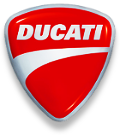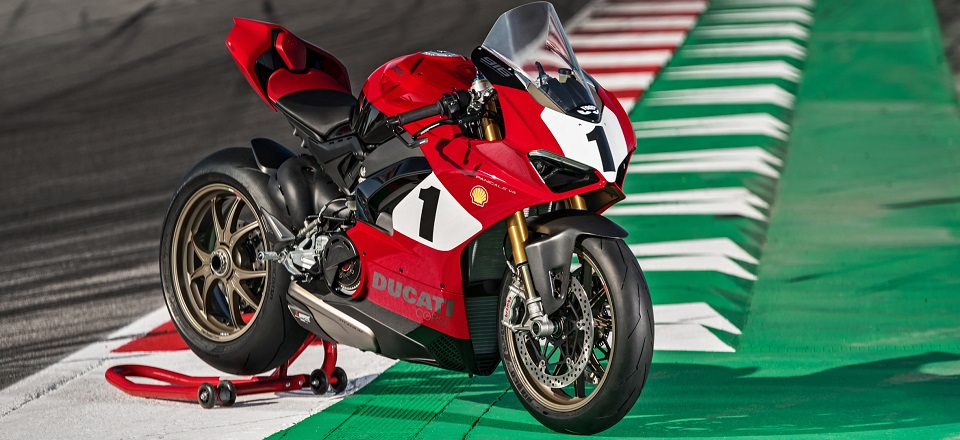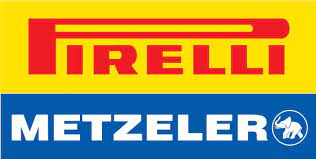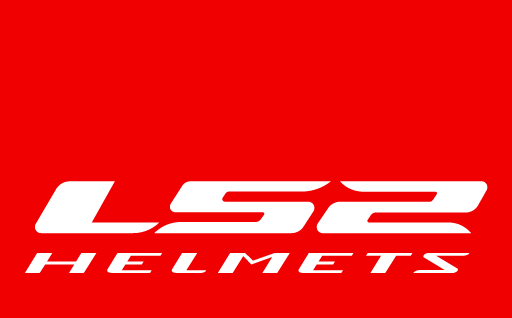The road version of the Panigale V4 R undergoes significant development, upgrading in all areas to be faster on the track and even more race-oriented.
The heart of the Panigale V4 R is the new 998 cc Desmosedici Stradale R, an engine capable of reaching a maximum engine speed of 16,500 rpm in sixth gear (16,000 in the other ratios) and delivering a maximum power of 218 hp at 15,500 rpm (Euro-5 compliant*), absolute benchmark values in the panorama of supersports bikes of the same displacement.
The new Desmosedici Stradale R, despite all the improvements, delivers slightly reduced performance compared to the previous version due to the limitation generated by the exhaust system complying with the strict Euro-5 homologation. The full potential of this engine, however, is expressed on the track by fitting the racing exhaust, which allows it to reach 237 hp, 3 hp more than the predecessor.
The peculiarity lies in the close ignition of the two cylinders on the left side and then those on the right side of the motorcycle, respectively. In the timing diagram, the ignitions are then placed at 0°, 90°, 290° and 380°.
This particular order of ignition gives the V4 a sound quite similar to that of the Desmosedici MotoGP.
The new Panigale V4 R adopts technical solutions reserved for MotoGP and Superbikes, such as "gun drilled" titanium connecting rods and pistons with DLC surface treatment.
Other interventions involve pistons with new geometry, a more aggressive intake cam profile, adoption of the same gear ratio used by bikes competing in World Superbike, and a new lighter dry clutch.
Greater effectiveness in track use is also achieved through electronic evolutions, such as the expansion and evolution of the Power Modes, the new Track Evo display on the dashboard, engine maps with dedicated calibration for each individual gear, refinements to the DTC and Ride By Wire throttle system, but also the Engine Brake Control EVO 2, the new strategy for the DQS, and the updated cooling fan control.
The Panigale V4 R also adopts a new throttle control that improves the rider's feeling when opening and managing the throttle.
ENGINE:
- Evolution of the 998 cc Desmosedici Stradale R Evo
-
The engine retains its top speed of 16,500 rpm in sixth gear, an unparalleled value in the supersport range of similar displacement, limiting the power loss to only 3 hp (218 hp at 15,500 rpm) despite the new Euro-5 homologation. By fitting the non-homologated racing exhaust, it is possible to take full advantage of all the upgrades made to the engine, and the maximum power figure can even reach 237 hp.
For the first time on a road bike, titanium connecting rods of the "gun drilled" type are used, that is, drilled longitudinally along the shaft (1.6 mm diameter hole). This solution, by allowing oil to flow from the head to the connecting rod foot, improves pin lubrication and thus reliability under extreme conditions.
- Aluminium pistons with DLC treatment
-
The pistons of the Desmosedici Stradale R have a skirt characterized by DLC (Diamond Like Carbon) surface treatment, a solution used in MotoGP and Formula 1 racing competition, which reduces friction between piston and liner and which is applied for the first time on a road engine. The pistons also have a new geometry that makes them 5 grams lighter (equal to 2% of their weight) thus reducing the forces of inertia, to the benefit of reliability.
- New piston geometry
-
The pistons also have a new geometry that makes them 5 grams lighter (equal to 2% of their weight) thus reducing the forces of inertia, to the benefit of reliability.
- Gearbox with SBK ratios
-
The gear ratio is the same as that used by bikes competing in World Superbike, with the lengthening of first (+11.6%) second (5.6%) and sixth gears (1.8). First gear then becomes usable in more corners of each circuit, offering the benefits of more engine braking on braking and better acceleration on exit. In addition, the smaller jump between first and second allows the DQS to work more effectively.
- "Gun Drilled" connecting rods
-
For the first time on a road bike, “gun drilled” titanium connecting rods are used, which are drilled longitudinally along the rod (1.6 mm diameter hole). This solution, allowing the passage of oil from the head to the small end, improves lubrication and reliability in extreme conditions.
- Camshafts
-
The four camshafts of the Desmosedici Stradale R engine have dedicated profiles that realize higher lift-offs than on the Desmosedici Stradale and move the sixteen valves with sizes of 34 mm in diameter for the titanium intake valves and 27.5 mm in diameter for the steel exhaust valves. The valves have titanium half-cones, a solution usually used only in competition engines.
ELECTRONICS
- New Info Mode "Track Evo"
-
In the "Track Evo" screen, the tachometer moves on a horizontal scale positioned in the highest part of the display, that is the most visible and the indication of the gear engaged is in the centre of the screen. In the right area of the display there are four different coloured sectors, each dedicated to an electronic control (DTC, DWC, DSC, EBC). These sectors light up individually when the electronics are working on a certain parameter, remaining on for the time necessary for the rider to identify which indicator is activated. This signalling mode makes it easier for the rider to understand the control that has actually worked to allow him to intervene more precisely and punctually on the choice of optimal level and to obtain better performance more quickly. The left sector completes the information with chronometer, number of laps completed and speed.
- New Engine Brake Control EVO 2 Software
-
To improve stability, precision and directionality in braking and corner entry phases and allow the rider to define more precisely the best electronic engine configuration on each circuit, the Panigale V4 R '23 also adopts the Engine Brake Control (EBC) EVO 2. This electronic engine brake management system features a different gear-by-gear calibration on each of the three selectable levels. The strategy was developed to optimize the intensity of the engine brake as a function of the load on the rear axle.
- New Ducati Quick Shift Strategy
-
In partialized throttle shifting, the strategy acts both by means of an injection cut of the previous strategy and with a reduction in advance, making the action smoother in road use thanks to the absence of engine shutdowns and re-starts.
In fully open throttle shifting, typical of track use, the DQS strategy is refined with an evolution of the torque restitution phase that guarantees more stability to the bike and a more homogeneous and therefore more profitable drive in the lap time.
- New cooling fan strategy
-
In addition to these changes, there is also an update of the cooling fan control strategy, now able to offer better management of operating temperatures while also reducing the accumulation of heat typical of the conclusion of track sessions. Furthermore, this strategy guarantees greater thermal comfort for the rider at the typical speeds of road use.
- New Power Mode Strategy
-
There are four engine strategies: Full, High, Medium, Low. Full and Low are newly designed, while the High and Medium configurations have been revised.
Full Power Mode allows the engine to express its full potential with torque curves without electronic filters, except for first gear. For the Medium and High Power Modes, a new Ride by Wire map management system has been developed with dedicated calibration for each of the six gears, which ensures the rider always obtains optimum drive every time the throttle is opened. The Low Power Mode, on the other hand, has been designed for riding on the road or for low-grip surfaces, limiting the maximum power of the bike to 160 hp and offering a particularly manageable throttle response.
- Ducati Data Analyser + GPS (DDA+ GPS)
-
The Ducati Data Analyser+ (DDA+) is a telemetry system. Similar to those used in competitions, it consists of a data acquisition device (via CAN line) and analysis software (for Windows or Mac PCs) that takes its inspiration from professional programmes.
The GPS allows to access the Lap Timer GPS (DLT GPS) EVO 2. It automatically detects the lap times and two intermediate times and display them directly on the dashboard at every ride-past. On each lap the system records the time, the maximum RPM, maximum speed (real, GPS-detected), intermediate times plus lean and yaw angles.
The system records 60 laps and 6 sessions and allows to save the coordinates of 5 different circuits. These can be recalled at the start of each track day without having to repeat the finish line and intermediate times set-up procedure. The default system settings feature the finish/intermediate coordinates of five iconic circuits: Laguna Seca, Mugello, Jerez, Sepang, Losail.
CHASSIS
- Öhlins long excursion fork
-
At the front, the Öhlins NPX25/30 pressurized fork increases its travel by 5 mm compared to the previous "R". This technical solution, combined with an Öhlins TTX36 shock absorber whose centre distance goes from 312 to 316 mm and a standard adjustment of the swingarm pivot to the +1 position, increases the rear height by 20 mm. In this way, a higher centre of gravity is achieved and therefore greater nimbleness in corner entry and changes of direction.
- New Öhlins TTX36 shock absorber
-
The adoption of a less rigid spring for the shock absorber (from 105 N/mm to 80 N/mm) and a lower ground load on the front due to the lengthening of the fork travel, as well as improving the ability to "copy” the asphalt accentuates load transfers by exploiting the greater negative travel of the suspension, increasing grip and feeling when entering corners
- Adjustable rear swingarm pivot height adjustable
-
The Panigale V4 R continues with the layout based on the “Front Frame” and single-sided aluminium swingarm of the Ducati Panigale family. It is possible to adjust the height of the rear swingarm pivot in 4 positions in 2 mm steps.
The position of the swingarm pivot accentuates the anti-squat effect by improving stability, precision and ability to maintain the trajectory when coming out of corners.
- Shock absorber with preload adjuster
-
To speed and simplify calibration, the rear shock absorber is equipped with hydraulic preload adjuster.
AERODYNAMICS
- New ergonomics
-
The superstructures of the Ducati supersports bike have also been updated, with the adoption of a brushed aluminium tank with a capacity increased to 17 litres and a profile that offers better support for the rider's arms and legs when braking and when cornering. The changes to the tank are added to a flatter saddle, with a reduced amount of foam and with a different covering, which on the one hand guarantees greater freedom of longitudinal movement, and on the other helps the rider to become more stable when necessary.
- New Wings
-
On the Panigale V4 R 2023 the aerodynamic package has also been revised with a view to greater efficiency: the new two-element wings (main + flap) guarantee the same aerodynamic load, but are more compact and thinner (respectively by 40% and 50%).
- New lower fairings
-
To improve the cooling of the engine, stabilizing its performance in extreme use on the circuit, the fairing has been modified in the layout of the extractors in the lower area, and complies with the World Superbike Championship regulations. Also in the lower part, on the left side, there is an air intake to cool the sensor of the Ducati Quick Shift.

























